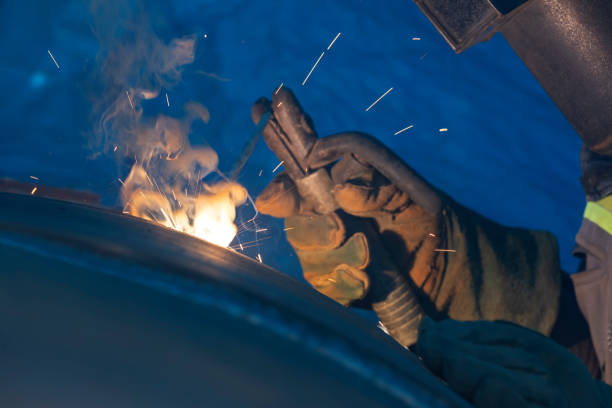Selecting the appropriate stick electrode is fundamental to achieving strong, high-quality welds. A well-informed choice can significantly enhance the integrity of your welds and streamline your welding process. Below is a comprehensive guide from Megmeet-welding highlighting key factors to consider when choosing your stick electrode.

I. Understand Your Base Metal
Identifying the properties of your base metal lays the groundwork for selecting the right electrode:
Surface Appearance: The metal's surface texture can provide clues about its type. For instance, a rough, grainy finish typically indicates cast iron, while a smooth surface suggests a more refined steel.
Magnetism: Use a magnet to test for ferrous and non-ferrous metals. Carbon and alloy steels are commonly magnetic, while stainless steels and non-ferrous alloys (like aluminum and copper) are not. This can guide your choice of electrode.
Sparks: Observing the spark characteristics when grinding or cutting the metal can also help identify the material. For example, high-carbon steels such as A-36 will produce bright, flaring sparks, while low-carbon steels yield softer, less dramatic sparks.
Chisel Test: If you can easily cut into the metal with a chisel, it's likely a soft metal like mild steel; harder metals will resist this test, indicating a need for more robust electrodes.
II. Match Tensile Strength
A successful weld must not only bond two pieces of metal but also ensure the joint can withstand the required loads in service. Matching the tensile strength of the electrode to that of the base metal is crucial:
AWS Classification: Each electrode is classified by American Welding Society (AWS) standards, where the first two digits indicate its minimum tensile strength. For example, an E6011 electrode, rated at least 60,000 psi, is well-suited for welding similar-strength steels. It’s important to select electrodes that meet or exceed your base material's tensile strength and toughness to avoid issues like cracking or failure during service.
III. Choose the Right Welding Current
Electrode performance can vary significantly depending on the type of current used:
DCEP (Direct Current Electrode Positive): Electrodes such as E6010 are ideal for deeper penetration and better arc stability, making them effective for welding over contaminants (like rust or oil).
DCEN (Direct Current Electrode Negative): Electrodes like E6012 provide a smoother arc and shallower penetration, making them suitable for bridging joints or fillet welds.
AC Compatible: Electrode types such as E6013 are versatile and produce a soft arc. This makes them a good choice for clean sheet metal applications, providing a fine surface finish and requiring less cleanup afterward.
You may also want to know How to Determine the Current and Voltage During Welding?
IV. Consider Material Thickness and Joint Fit-Up
The thickness of the material and the nature of the joint fit-up are critical in electrode selection:
Thicker Materials: For heavier sections, choose electrodes with high ductility and low hydrogen characteristics (such as those classified AWS 15, 16, or 18). These will minimize the risk of hydrogen-induced cracking.
Thinner Materials: Utilize electrodes like E6013, which are designed to produce a softer arc that helps prevent burn-through during the welding process. They provide good control and metal deposition rates, which are crucial for thin materials.
Evaluating joint design also matters. For tight tolerances in joint fit-up, electrodes like E6010 and E6011 create a digging arc, allowing for better penetration. For wider gaps, choose E6012 to help create a concave weld face for a smooth finish.
V. Assess Welding Position
Different welding positions require differently classified electrodes:
1: Acceptable for flat, horizontal, vertical, and overhead (e.g., 7018).
2: Suitable primarily for flat and horizontal positions (e.g., 6013).
Understanding the required positions helps ensure you select an electrode that will perform optimally in your specific welding scenario. You may also want to know What are the 4 Basic Welding Positions and How to Choose the Right One.
VI. Review Specifications and Service Conditions
The conditions in which the welded part will operate can heavily influence electrode selection:
Temperature and Environmental Conditions: In high heat or extreme cold environments, low-hydrogen electrodes are vital. Electrodes with higher ductility resist cracking in fluctuating temperatures, providing long-lasting welds.
Specific Applications: For critical applications, such as pressure vessels, piping, or structural welds, comply with specific codes and standards that may dictate the exact electrode types you must use, ensuring safety and reliability.
VII. Account for Environmental Job Conditions
Preparing your base metal appropriately is essential for achieving a sound weld:
Cleaning the Surface: Proper preparation involves removing mill scale, rust, grease, and moisture. Clean surfaces help prevent porosity and enhance the strength of the weld. If cleaning is not possible, electrodes like E6010 and E6011 are known for their ability to weld through contaminants.
Contaminant Resistance: Ensure that the electrode selected can effectively handle contaminants. Low-hydrogen electrodes are generally preferred in preventing porosity, while electrodes designed specifically for contaminated surfaces, like E6010, can be effective in fieldwork or less-than-ideal conditions.
VIII. Final Tips for Electrode Selection
Navigating the complexities of electrode selection can be simplified by considering these outlined factors. Remember, while there might be several suitable options for a given application, understanding your specific needs will lead to better outcomes.
Equipped with this knowledge, you can confidently choose the right stick electrode for your welding tasks, ensuring both quality and efficiency in every weld.
Related articles:
1. Stick Welding Electrode Selection & Techniques Guide
2. A Guide to Arc Welding Electrodes
3. Tungsten Electrodes Basics: Types, Pros & Cons, Selection, Maintenance
4. How To Shape Tungsten Electrode For TIG Welding?
5. How to Identify and Solve Tungsten Electrode and Arc Issues




